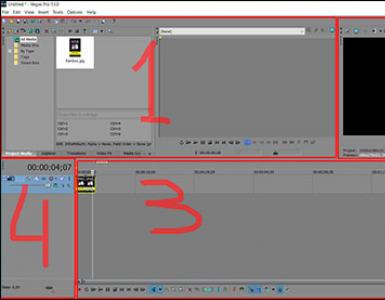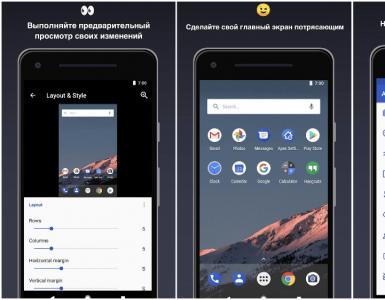Accessing hidden folders in windows 7. Accessing hidden folders in Windows
How to open access to hidden folders and files in Windows 7 XP
Hidden folders and files
In the Windows operating system, folders and files can be hidden. That is, in the properties of a folder or file there is a “hidden” attribute and you will not be able to see or enter this folder, for example, through “My Computer”.
Often, critical system folders are made hidden folders so that the user cannot delete or change important files. But viruses can also hide in hidden folders.
The folder in which Windows XP and Windows 7 stores temporary files, that is, garbage, is also hidden.
How to open access to hidden and system folders and files
There are times when you need to open access to hidden and system folders in Windows 7 or XP. For example, to find and manually remove hidden virus files or clean the temporary folder. Below are step-by-step instructions on how to open access to hidden folders and files in Windows XP and Windows 7
Accessing hidden folders in Windows XP
1. Open My computer. From the menu bar, select Tools - Folder Options.
2. In the window that opens, go to the tab View and uncheck the box. In the Hidden files and folders item, make the item active Show hidden files and folders.

Otherwise, the extensions of files with which installed programs are associated are not shown. That is, if you have Word installed, then the extension for .doc files is not displayed. Virus files are often designed to do this. After all, the .exe extension (executable file) is also not shown. Typically, viruses with the .exe extension have an icon for an MS Word document, video file, or other common program. Assuming you open a video file or document, you are running a file with the extension .exe, which is an executable file - that is, a virus program.
To avoid such misunderstandings, it is useful to see the true extension of the file being launched. To do this, uncheck the specified item in the list.
Now click OK. The window will close, and all folders, including hidden ones, will be displayed in Explorer.
Accessing hidden folders in Windows 7
1. Go to the Start menu - Control Panel

2. Select an item Design and personalization
3. Select a menu item Folders settings
4. Go to the tab View. Uncheck the box Hide protected system files (recommended). Enable item Show hidden files, folders and drives.

Click OK. Now all folders and files will be displayed, including hidden and system ones.
The standard Windows file manager has a function for hiding directories. It is designed to tidy up the list of folders by removing from it everything that the user never (or rarely) accesses. For example, this is useful for the “Documents” directory in the home directory, because programs and games write data there, and if there are a lot of applications installed, then a mess appears in the corresponding folder.
However, this is not the only purpose of this function. Next, users will be able to learn how to open hidden folders in Windows 7/8/10, however, it is worth noting that it can also be used to hide sensitive information. After all, often you don’t want to give access to it to just anyone. However, this is naturally not the most reliable way to store such data. For these purposes, it is better to use password-protected archives or virtual disk partitions created in TrueCript.
Enabling showing hidden folders
If certain folders are hidden by a user, system, or application (but not by a virus), then accessing their contents is easy. The easiest way to accomplish this and display it is to make it visible.
How to show hidden folders through the Control Panel?
The corresponding operation can be performed through the "Control Panel":

The result of these actions will be the display of all directories that were previously invisible.
How to see hidden folders through "Organize"?
You don’t have to go into Control Center, but get access to options for displaying directories (including hidden folders) directly through the file manager. This is done like this:

The effect of these manipulations is similar to the settings made through the Control Center. This method is especially useful for those who often have to turn on the display of hidden directories, and then soon hide them from view again.
How to find hidden directories using Total Commander?
Total Commander is one of the most popular third-party file managers for Windows 7, 8, 10 and earlier systems.

Its official build does not display hidden directories by default, but this is easy to fix:

How to make a hidden directory always visible?
Making a hidden folder always visible in TC is simple:

This is also easy to do in a standard file manager:

Accessing the contents of a hidden folder without changing the configuration
There is a way to access what is contained in the hidden directory without changing settings or attributes. However, it only works in cases where only the folder itself is hidden, but not its subdirectories and files.
To do this, you need to know the name of the folder that is not displayed in the file manager, as well as the full path to it. If this information is known, then you need to write it in the address bar of the file manager, and then press Enter. For example, if the Images folder is hidden in the root of drive C, then to gain access to its contents you will need to enter the following in the address bar: C:\Images.
Hiding directories is a useful feature that allows you to tidy up the lists of directories and files on your hard drive. In addition, it can be used to hide certain information from prying eyes of not very computer-savvy users.
If you found this article useful, and the information in it helped resolve the issue, please rate it and share the page with your friends. We are waiting for your comments! Thank you!
If you are trying to find the system folder, but do not find it in the right place, you need to check - it may be hidden.
The Windows operating system is configured by default so that the main system files and folders have the "Hidden" attribute. This is done in order not to burden the user with unnecessary information and to limit his access to system settings. After all, not everyone has the necessary knowledge and experience.
If you know exactly what needs to be done and you need to open hidden Windows folders, use our instructions.
Opening hidden folders in Windows 7
Let's start with this version of the operating system. So, we are faced with the task of finding hidden folders. Let's say we are looking for a folder - recovery points are stored in it. It is located on any disk for which the recovery function is enabled. And it's hidden by default.
In our example, for the system drive "C:/" this function is activated. But the folder we need is missing in the picture. How can we make it viewable?
Click "Start", then " Control Panel". Here we look for the "Folder Options" icon - click on it. In the window that opens, go to the "View" tab, and scroll the list of parameters to the end.

Here we need to configure the parameters as follows:
- Hide protected system files"
- Uncheck the box next to " Hide extensions for registered file types"
- Select the item " Show hidden files, folders and drives"

Then "Apply" and "OK".
Let's check. We return to the drive "C:\".

As you can see in the figure, the hidden folder System Volume Information has become available for viewing. Now you can work with it, and with other hidden files and folders.
Hidden folders in Windows 8
In the new version of the operating system, we have two options for opening hidden system folders.
Method 1
Everything ingenious is simple. If you know the exact name of the hidden folder, go to the directory in which it should be located. In our example, we continue to work with the System Volume Information folder. It is located on drive "C". Open it and write the name of the desired folder in the address bar:

It will open - it's very simple!
Method 2
This method is similar to the one we used when working with Windows 7.
So, open Explorer, go to any folder, it doesn’t matter.
On the top menu bar, click the "View" button, then "Options". You will see a window for configuring folder display options (like in Windows 7).

Video for the article:
Conclusion
Unless absolutely necessary, you should not work with important system files and settings. This may cause the operating system to fail. Be as careful as possible. Viewing hidden folders in Windows may very rarely be needed by the average user
In the event that your actions led to the failure of the operating system, use.
If you want to play an Android application on a personal computer, you will need.
If you decide to reinstall Windows, you will need .
Why look for information on other sites if everything is collected here?
Accessing hidden Windows folders
Hidden folders and files
In the Windows operating system, folders and files can be hidden. That is, in the properties of a folder or file it is
attribute “hidden” and you won’t be able to see or enter this folder, for example, through “My Computer”.
Often, critical system folders are made hidden folders so that the user cannot delete or change important files. But viruses can also hide in hidden folders.
The folder in which Windows XP and Windows 7 stores temporary files, that is, garbage, is also hidden.
How to open access to hidden and system folders and files
There are times when you need to open access to hidden and system folders in Windows 7 or XP. For example, to find and manually remove hidden virus files or clean the temporary folder. Below are step-by-step instructions on how to open access to hidden folders and files in Windows XP and Windows 7
Accessing hidden folders in Windows XP
1. Open My Computer. From the menu bar, select Tools – Folder Options.
2. In the window that opens, go to the View tab and uncheck Hide protected system files (recommended). In the Hidden files and folders item, make the Show hidden files and folders item active.
Otherwise, the extensions of files with which installed programs are associated are not shown. That is, if you have Word installed, then the extension for .doc files is not displayed. Virus files are often designed to do this. After all, the .exe extension (executable file) is also not shown. Typically, viruses with the .exe extension have an icon for an MS Word document, video file, or other common program. Assuming you open a video file or document, you are running a file with the extension .exe, which is an executable file - that is, a virus program.
To avoid such misunderstandings, it is useful to see the true extension of the file being launched. To do this, uncheck the specified item in the list.
Now click OK. The window will close, and all folders, including hidden ones, will be displayed in Explorer.
Accessing hidden folders in Windows 7
1. Go to the Start menu - Control Panel
2. Select Appearance and Personalization
3. Select the menu item Folder Options
4. Go to the View tab. Uncheck Hide protected system files (recommended). Turn on Show hidden files, folders and drives.
Click OK. Now all folders and files will be displayed, including hidden and system ones.
This entry was posted in. Bookmark the .
In the Windows operating system, folders and files can be hidden. That is, in the properties of a folder or file there is a “hidden” attribute and you will not be able to see or enter this folder, for example, through “My Computer”.
Often, critical system folders are made hidden folders so that the user cannot delete or change important files. But viruses can also hide in hidden folders.
The folder in which Windows XP and Windows 7 stores temporary files, that is, garbage, is also hidden.
How to open access to hidden and system folders and files
There are times when you need to open access to hidden and system folders in Windows 7 or XP. For example, to find and manually remove hidden virus files or clean the temporary folder. Below are step-by-step instructions on how to open access to hidden folders and files in Windows XP and Windows 7
Accessing hidden folders in Windows XP
1. Open My computer. From the menu bar, select Tools - Folder Options.
2. In the window that opens, go to the tab View and uncheck the box Hide protected system files (recommended). In point Hidden files and folders make the item active Show hidden files and folders.

Otherwise, the extensions of files with which installed programs are associated are not shown. That is, if you have Word installed, then the extension for .doc files is not displayed. Virus files are often designed to do this. After all, the .exe extension (executable file) is also not shown. Typically, viruses with the .exe extension have an icon for an MS Word document, video file, or other common program. Assuming you open a video file or document, you are running a file with the extension .exe, which is an executable file - that is, a virus program.
To avoid such misunderstandings, it is useful to see the true extension of the file being launched. To do this, uncheck the specified item in the list.
Now click OK. The window will close, and all folders, including hidden ones, will be displayed in Explorer.
Accessing hidden folders in Windows 7
1. Go to the menu Start - Control Panel

2. Select an item Design and personalization

3. Select a menu item Folders settings

4. Go to the tab View. Uncheck the box Hide protected system files (recommended). Enable item Show hidden files, folders and drives.

Click OK. Now all folders and files will be displayed, including hidden and system ones.













